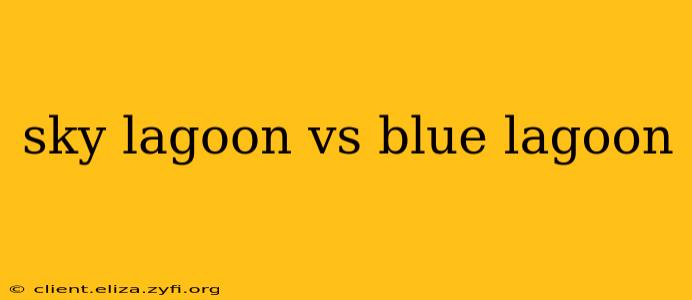Iceland, the land of fire and ice, boasts stunning natural wonders, and its geothermal spas are among its most captivating attractions. Two names consistently top the list: the Blue Lagoon and the Sky Lagoon. Both offer luxurious geothermal experiences, but which one reigns supreme? This comparison delves into the key differences to help you choose the perfect Icelandic spa escape.
What is the main difference between Sky Lagoon and Blue Lagoon?
The most significant difference lies in their size and atmosphere. The Blue Lagoon is a massive, established spa with a bustling, almost festival-like atmosphere, especially during peak season. Sky Lagoon, on the other hand, is smaller and more intimate, prioritizing a tranquil and luxurious experience. It’s a more refined, less crowded alternative. This difference shapes the overall experience, impacting everything from crowd levels to the type of relaxation you’ll find.
Which is cheaper, Sky Lagoon or Blue Lagoon?
Generally, the Sky Lagoon is slightly less expensive than the Blue Lagoon. However, prices fluctuate depending on the season and the package chosen. Both spas offer different entry packages, including add-ons like massages and other treatments, significantly influencing the final cost. It’s crucial to check their respective websites for the most up-to-date pricing before your visit.
Is Sky Lagoon better than Blue Lagoon?
There's no single "better" spa; it entirely depends on your preferences. If you prefer a grand, lively atmosphere with plenty of amenities and activities, the Blue Lagoon is likely the better choice. If you desire a more peaceful, intimate experience with a strong emphasis on relaxation and breathtaking views, the Sky Lagoon is the winner.
What are the pros and cons of each spa?
Blue Lagoon Pros:
- Larger scale: More amenities, activities, and space to explore.
- Established reputation: A world-renowned spa with a long history.
- More diverse offerings: Wider range of treatments and packages available.
- Multiple silica mud masks: Offers various mud mask applications for a more diverse experience.
Blue Lagoon Cons:
- Crowded: Can be very busy, especially during peak season.
- Higher price point: Generally more expensive than Sky Lagoon.
- Less intimate: The vast size can detract from a sense of tranquility.
Sky Lagoon Pros:
- Smaller, intimate setting: Offers a more peaceful and relaxing atmosphere.
- Stunning ocean views: Boasts breathtaking panoramic views of the Atlantic Ocean.
- Seven-step ritual: A unique and structured spa experience focusing on relaxation and rejuvenation.
- Modern and sleek design: A visually appealing and contemporary spa.
Sky Lagoon Cons:
- Smaller scale: Fewer amenities and activities compared to the Blue Lagoon.
- Less established: Newer compared to Blue Lagoon, so it may lack the same historical significance.
- May book up quickly: Its popularity means securing a time slot is essential.
Which is better for families?
Both spas cater to families, but the Blue Lagoon's larger size and greater variety of activities may be more appealing to families with children. Sky Lagoon's more intimate setting might be better suited for families seeking a more relaxing and less chaotic experience.
Which lagoon is closer to Reykjavik?
The Blue Lagoon is located further from Reykjavik than Sky Lagoon. Sky Lagoon offers easier accessibility for those who value convenience. However, both spas provide shuttle services from Reykjavik, making transportation relatively straightforward.
Conclusion
Choosing between the Blue Lagoon and Sky Lagoon depends entirely on your personal preferences and priorities. The Blue Lagoon is the established giant, offering a lively atmosphere and a wider range of amenities. Sky Lagoon offers a more intimate, refined experience with stunning ocean views. Carefully consider your desired level of activity, crowd preference, and budget when making your decision. Both spas, however, offer unforgettable experiences in Iceland’s breathtaking geothermal landscape.
